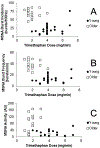Aging Alters the Relative Contributions of the Sympathetic and Parasympathetic Nervous System to Blood Pressure Control in Women
- PMID: 30354803
- PMCID: PMC6211807
- DOI: 10.1161/HYPERTENSIONAHA.118.11550
Aging Alters the Relative Contributions of the Sympathetic and Parasympathetic Nervous System to Blood Pressure Control in Women
Abstract
Autonomic support of blood pressure increases with age in humans. Large differences exist in the dose of trimethaphan (TMP) required for ganglionic blockade in young and older women. We asked whether differences in the dose of TMP required to achieve ganglionic blockade are because of differences in the relative contributions of the sympathetic and parasympathetic nervous system in control of blood pressure with age. Muscle sympathetic nerve activity (microneurography, peroneal nerve), heart rate (HR), and blood pressure were recorded before and during incremental doses of TMP camsylate until ganglionic blockade was achieved (absence of muscle sympathetic nerve activity and <5-bpm increase in HR during a valsalva maneuver; final TMP dose, 1-7 mg/min). HR variability was analyzed from the ECG waveform (WinCPRS). The dose of TMP required to achieve ganglionic blockade is positively related to basal HR variability, where women with high HR variability require a higher dose of TMP to achieve ganglionic blockade. In contrast, baseline muscle sympathetic nerve activity is inversely related with the dose of TMP required to achieve ganglionic blockade, such that women with high basal muscle sympathetic nerve activity required a lower dose of TMP. As such, the change in HR with ganglionic blockade was positively related, and the change in mean arterial pressure was inversely related, with the dose of TMP required to achieve ganglionic blockade. These data suggest loss of parasympathetic tone and increased sympathetic tone with aging contribute to the increase in blood pressure with age in women and dictate the dose of TMP that is necessary to achieve ganglionic blockade.
Keywords: aging; blood pressure; humans; physiology; women.
Figures



Similar articles
-
Aging enhances autonomic support of blood pressure in women.Hypertension. 2014 Feb;63(2):303-8. doi: 10.1161/HYPERTENSIONAHA.113.02393. Epub 2013 Dec 9. Hypertension. 2014. PMID: 24324040 Free PMC article. Clinical Trial.
-
Neural control of blood pressure in women: differences according to age.Clin Auton Res. 2017 Jun;27(3):157-165. doi: 10.1007/s10286-017-0403-0. Epub 2017 Feb 16. Clin Auton Res. 2017. PMID: 28205011 Free PMC article.
-
Influence of sympathetic nerve activity on aortic hemodynamics and pulse wave velocity in women.Am J Physiol Heart Circ Physiol. 2017 Feb 1;312(2):H340-H346. doi: 10.1152/ajpheart.00447.2016. Epub 2016 Dec 6. Am J Physiol Heart Circ Physiol. 2017. PMID: 27923789 Free PMC article.
-
Assessment of cardiovascular autonomic function.Clin Neurophysiol. 2006 Apr;117(4):716-30. doi: 10.1016/j.clinph.2005.09.027. Epub 2006 Feb 7. Clin Neurophysiol. 2006. PMID: 16464634 Review.
-
From Brain to Blood Vessel: Insights From Muscle Sympathetic Nerve Recordings: Arthur C. Corcoran Memorial Lecture 2020.Hypertension. 2021 May 5;77(5):1456-1468. doi: 10.1161/HYPERTENSIONAHA.121.16490. Epub 2021 Mar 29. Hypertension. 2021. PMID: 33775112 Review.
Cited by
-
Association of Resting Heart Rate With Blood Pressure and Incident Hypertension Over 30 Years in Black and White Adults: The CARDIA Study.Hypertension. 2020 Sep;76(3):692-698. doi: 10.1161/HYPERTENSIONAHA.120.15233. Epub 2020 Aug 12. Hypertension. 2020. PMID: 32783760 Free PMC article.
-
Device-based neuromodulation for cardiovascular diseases and patient' s age.J Geriatr Cardiol. 2022 Nov 28;19(11):876-893. doi: 10.11909/j.issn.1671-5411.2022.11.003. J Geriatr Cardiol. 2022. PMID: 36561057 Free PMC article.
-
Sports activities at a young age decrease hypertension risk-The J-Fit+ study.Physiol Rep. 2022 Jun;10(12):e15364. doi: 10.14814/phy2.15364. Physiol Rep. 2022. PMID: 35757903 Free PMC article.
-
Efficacy and safety of nebivolol in Korean patients with hypertension by age and sex: a subanalysis from the BENEFIT-KOREA study.Clin Hypertens. 2021 Mar 15;27(1):9. doi: 10.1186/s40885-021-00165-3. Clin Hypertens. 2021. PMID: 33722290 Free PMC article.
-
Assessment of resistance vessel function in human skeletal muscle: guidelines for experimental design, Doppler ultrasound, and pharmacology.Am J Physiol Heart Circ Physiol. 2020 Feb 1;318(2):H301-H325. doi: 10.1152/ajpheart.00649.2019. Epub 2019 Dec 30. Am J Physiol Heart Circ Physiol. 2020. PMID: 31886718 Free PMC article. Review.
References
-
- Christou DD, Jones PP, Jordan J, Diedrich A, Robertson D and Seals DR. Women have lower tonic autonomic support of arterial blood pressure and less effective baroreflex buffering than men. Circulation. 2005;111:494–8. - PubMed
Publication types
MeSH terms
Substances
Grants and funding
LinkOut - more resources
Full Text Sources
Research Materials

